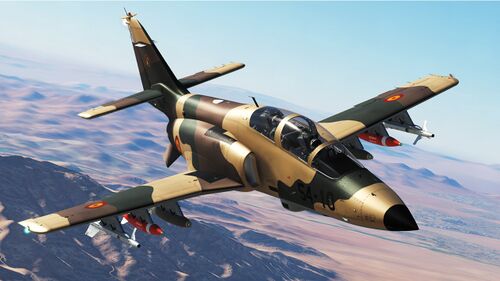ARCSA AL-80 Águila
This article is incomplete because it is pending further input from participants, or it is a work-in-progress by one author. Please comment on this article's talk page to share your input, comments and questions. Note: To contribute to this article, you may need to seek help from the author(s) of this page. |
| Aviones Reales Consolidados SA AL-80 Águila | |
|---|---|

. | |
| Artist rendering of the ARCSA AL-80 in attack configuration during development | |
| Role | Advanced trainer Light attack |
| National origin | |
| Manufacturer | Aviones Reales Consolidados SA (ARCSA) |
| First flight | March 1, 1988 |
| Introduction | July 11, 1991 |
| Status | In service |
| Primary user | Royal Mejian Army Air Corps |
The Royal Consolidated Aircraft SA AL-80 Águila is a is a low-wing single engine jet-powered advanced trainer and light attack aircraft designed and manufactured by Costa Mejian aircraft company Aviones Reales Consolidados SA. It was developed in the closing years of the Omandan Continental War following the removal of Soviet Order forces from Costa Mejis. Introduced in 1991, the aircraft saw limited service with the Royal Mejian Army Air Corps in the closing days of the war. Modernly, it continues to serve the Royal Mejian Army Air Corps as both an advanced trainer aircraft, as well as providing close air support to Mejian ground forces, as well as forces stationed in Costa Mejis by the Patrian Legion, both of whom are involved in ongoing counterinsurgency operations both within northern Costa Mejis as well as neighboring nations.
Design and development
Operational history
Variants
- AL-80: Initial production version utilized as an advanced trainer aircraft
- AL-80A: Upgrades performed in the mid-2000s enhancing the aircraft electronics and weapons systems
Operators
 Costa Mejis
Costa Mejis
 Shenandoah
Shenandoah
- Shenandoahan Air National Guard - The Shenandoahan Air National Guard operates a total of 12 aircraft designated as the A-3 Havoc. These aircraft are assigned to the 103rd Tactical Strike Squadron stationed at Ross Byrddie Air National Guard Base in Kanawha
Specifications
General characteristics
- Crew: 2
- Length: 12.5 m (41 ft 0 in)
- Wingspan: 10.6 m (34 ft 9 in)
- Height: 4.25 m (13 ft 11 in)
- Wing area: 20 m2 (220 sq ft)
- Aspect ratio: 5.6
- Powerplant: 1 × Obras de Motor Real OMR MTR-21541 turbofan engine, 19.13 kN (4,300 lbf) thrust
Performance
- Maximum speed: 769 km/h (478 mph; 415 kn) at 4,500 kg (9,921 lb) at sea level
- Cruise speed: 656 km/h (408 mph; 354 kn) / M0.6 at 9,145 m (30,003 ft)
- Stall speed: 183 km/h (114 mph; 99 kn)
- Never exceed speed: 834 km/h (518 mph; 450 kn) / M0.8 at 4,500 kg (9,921 lb)
- Combat range: 519 km (322 mi; 280 nmi)
- Ferry range: 2,000 km (1,243 mi; 1,080 nmi) with 30 minutes reserve
- Endurance: typical armed patrol – 3 hours 30 minutes
- Service ceiling: 12,800 m (42,000 ft)
- Rate of climb: 24.9 m/s (4,900 ft/min)
- Thrust/weight: 0.322
- Take-off run: 560 m (1,837 ft)
- Landing run from 15 m (49 ft): 800 m (2,625 ft)
Armament
- Guns: 1 x GIST 30 30 mm autocannon
- Missiles: 1x pylons located on the outboard portion of each wing for various types of IR-guided air-to-air missiles including the AIM-95, MD.2113 Mystique or MD.2115/MD.2213 Rouchet
- Bombs: Up to 2,220 kg (4,894 lb) disposable stores on 6 underwing pylons able to carry a variety of air to ground missiles, guided and unguided freefall bombs